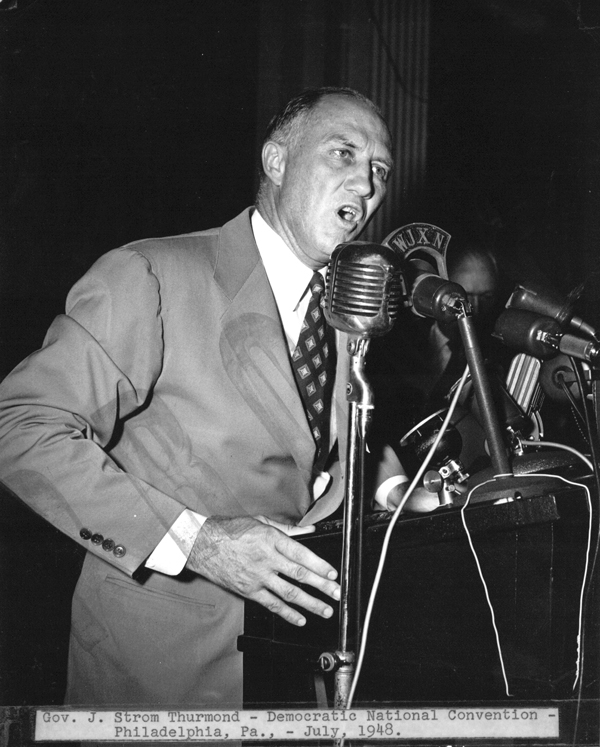The Dixiecrats were members of the States’ Rights Democratic Party, which splintered from the Democratic Party in 1948. The faction consisted of malcontented southern delegates to the Democratic Party who protested the insertion of a civil rights plank in the party platform and U.S. president Harry S. Truman’s advocacy of that plank. Before the convention southern delegates were dismayed by Truman’s 1948 executive order to desegregate the armed forces. With that backdrop many southern delegates were already concerned as they headed to the 1948 Democratic convention.

Courtesy of the Strom Thurmond Institute of Government and Public Affairs, Clemson University
When the Democratic national convention convened in July 1948, some Alabama and Mississippi delegates were prepared to walk out of the convention if the civil rights platform passed. When it did, all of the Mississippi delegates and half of the Alabama delegates stormed out of the convention. On July 17, 1948, the Alabama and Mississippi delegations, and a few individual delegates from other southern states, met in Birmingham, Alabama, to select a presidential ticket to oppose the Democrats. The Dixiecrats chose South Carolina’s governor, Strom Thurmond, for president and Fielding L. Wright, governor of Mississippi, for vice president.
The goal of the Dixiecrats was twofold. First, the splinter party hoped to deny both the Democrats and Republicans a majority in the electoral college, forcing the election into the U.S. House of Representatives. Second, Dixiecrat leaders maneuvered to have the Thurmond-Wright ticket declared the “official” Democratic Party ticket on the ballots of all southern states. In the end this ploy succeeded only in Alabama, Louisiana, Mississippi, and South Carolina, all Deep South states. Georgia was the lone Deep South state to remain loyal to the national Democratic Party; the Dixiecrat ticket appeared on Georgia ballots as a third party.

Courtesy of the Strom Thurmond Institute of Government and Public Affairs, Clemson University
On election day 1948, the Dixiecrats won Alabama, Louisiana, Mississippi, and South Carolina but failed to win any state in which Thurmond appeared as a third-party candidate. In Georgia, Thurmond came in a distant second to Truman. A closer analysis of the Dixiecrat phenomenon revealed an interesting pattern: the Dixiecrats were most successful in the states and counties where Black citizens were the most numerous. The Deep South states boasted the largest Black populations, and white voters in those states were the most determined to preserve racial segregation and Black disenfranchisement, and thus were more likely to vote for the Dixiecrat ticket. A similar trend is evident in county-level election returns, in which Thurmond was more likely to win counties where Black populations were large and white voters feared racial change. In the border South, where Blacks were less abundant and white voters were less preoccupied with segregation, support for the Dixiecrat candidates was negligible.
Although the Dixiecrats immediately dissolved after the 1948 election, their impact lasted much longer. Many white voters who initially cast Dixiecrat ballots gravitated back toward the Democratic Party only grudgingly, and they remained nominal Democrats at best. Ultimately, the Dixiecrat movement paved the way for the rise of the modern Republican Party in the South.






